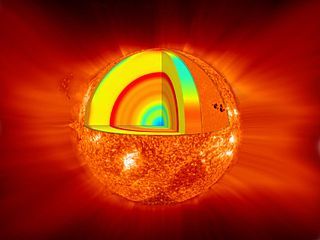How Much Energy Does the Earth Receive From the Sun?

Friend: Per the US Bureau of Labor Statistics, sunlight is the most abundant source of potential energy on the planet. If harnessed properly, sunlight could easily exceed current and future electricity demand. According to the Department of Energy, every hour, enough energy from the sun reaches Earth to meet the world’s energy usage for an entire year.
Craig: Yes. We get 6000 times more power from the sun than all seven billion of us use.
Friend: It appears that we get even more than that, according to the DOE — 8,760 vs. 6000. What’s the source of your 6,000 figure?
Craig: Gosh, I don’t remember; I’ve been using that number for years. It’s the enormous total power of the sun times the infinitessimally small fraction that the Earth occupies in the surface area of a sphere 93 million miles in radius.
In any case, the real point, obviously, is that it’s a ton more than we need; the challenge incumbent on us is to harvest it cost-effectively — and we’re very close. Btw, that’s what blows my mind about the effectiveness of the PR hatchet-job that the entrenched interests have done to create renewable energy naysayers. There are tens of millions of Americans who completely scorn the concept of solar and wind, on the basis that they are told it’s outrageously expensive. It’s not. We’re very close to grid-parity. With a little effort, we’ll be there soon. Even without that effort, we’ll get there eventually. The question is how long the fossil fuels and nuclear people will continue to dominate the landscape, and how much damage we will have done to our home planet in the process.

Craig,
My suspicion here is that the DOE is exaggerating. Of course I believe that the 6000-fold figure you use is also an exaggeration.
The math errors lie in the principle that the only solar energy that we can legitimately discuss is the solar energy that strikes the planet. The energy that hits the upper atmosphere exactly perpendicular to the Earth (which I believe is what the DOE uses to derive its number) is meaningless… But in the same vein calculating out a number assuming the amount of energy that hits the planet at the equator at noon without clouds is equally exaggerating.
If you look at the total sphere of Earth, and include the albedo effect of clouds, the average insolation of the planet works out to be ~250 W/m2. That’s handy, because that works out to something quite close to 1 TWh/km2/y. The U.S. has ~9.8 million km2, so the total insolation of the U.S. will be reasonably close to ~10,000 PWh. America uses ~4 PWh in electricity, so it likely receives ~2500 times as much solar energy as it uses in electricity. But if you only look at raw fossil energy and include natural gas used for heat and petroleum used for cars, you find we get about 800-1000 times as much energy from the sun as we use.
Still a good number. I don’t know why the renewables lobbies chose to exaggerate the number to that extent… and I really don’t know why the DOE felt it needed to double down and further exaggerate the number. Reality looks good enough.
*shrug*
“We get 6000 times more power from the sun than all seven billion of us use.”
Why is this more relevant than knowing the distance between Ganymede and Jupiter?
Most of the sun’s energy that is received by the earth is received over areas where collecting it would be either impractical or impossible. Most of the earth is covered by water. Surely no one would propose covering most of the ocean area with solar collectors.
I’m more interested in numbers that can be put to practical use.
“Why is this more relevant than knowing the distance between Ganymede and Jupiter and has been repeated many times and in many places.”
The 6000 and 7 billion numbers that Craig mentions are both highly relevant to our own planet and our biosphere, and these numbers he shares obviously serve to encourage the wider acceptance of the known and demonstrated viability of solar thermal, and solar energy applications in general, among readers who have not been exposed to the numbers elsewhere.
In contrast, the distance between Ganymede and Jupiter is useless to nearly all but astronomers and spaceflight technicians. I strongly suspect that you must have realized that your comparison is complete hyperbole, and therefore not particularly useful in itself.
Your comment reveals a level of antagonism toward solar thermal that is quite unwarranted, given the potential of efficient High Voltage Direct Current transmission over long distances from both ideal and highly suitable climate areas that are widely dispersed in many nations (and therefore available to nearly all nations), and given the recent advances that resolve concerns about storage. Indeed, people in Germany are looking at solar generation in Africa for consumers in Europe.
Solar thermal a relatively simple and highly elegant solution set that is being seriously pursued by entities both commercial and governmental, and they are thoroughly considering and addressing your aging concerns. Advances continue and efficiencies increase – it is only a matter of time and political will.
I think earth takes up 56% of the sun’s heat.